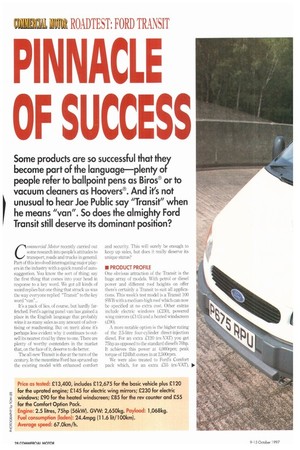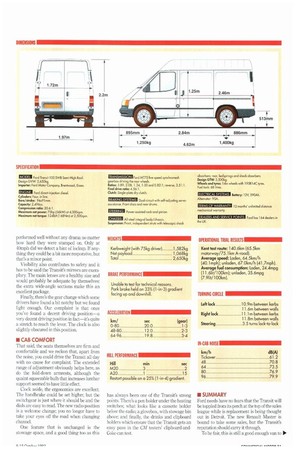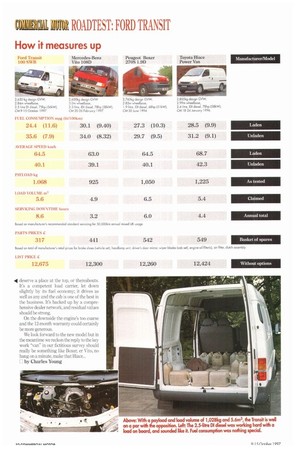ROADTEST: FORD TRANSIT
Page 30

Page 32

Page 33

Page 34

If you've noticed an error in this article please click here to report it so we can fix it.
PINNACLE OF SUCCESS
Some products are so successful that they become part of the language—plenty of people refer to ballpoint pens as Biros® or to vacuum cleaners as Hoovers®. And it's not unusual to hear Joe Public say "Transit" when he means "van". So does the almighty Ford Transit still deserve its dominant position?
Commercial Mohr recently carried out some research into people's attitudes to transport, roads and trucks in general. Part of this involved interrogating major players in the industry with a quick round of autosuggestion. You know the sort of thing; say the first thing that comes into your head in response to a key word. We got all kinds of weird replies but one thing that struck us was the way everyone replied "Transit" to the key word "van"...
It's a pack of lies, of course, but hardly farfetched. Ford's ageing panel van has gained a place in the English language that probably wins it as many sales as any amount of advertising or roadtesting. But on merit alone it's perhaps less evident why it continues to outsell its nearest rival by three to one. There are plenty of worthy contenders in the market that, on the face of it, deserve to do better.
The all-new Transit is due at the turn of the century In the meantime Ford has spruced up the existing model with enhanced comfort and security. This will surely be enough to keep up sales, but does it really deserve its unique status?
• PRODUCT PROFILE
One obvious attraction of the Transit is the huge array of models. With petrol or diesel power and different roof heights on offer there's certainly a Transit to suit all applications. This week's test model is a Transit 100 SWII with a medium-high roof which can now be specified at no extra cost. Other extras include electric windows (E230}, powered wing mirrors (£145) and a heated windscreen (£90).
A more notable option is the higher rating of the 2.5-litre four-cylinder direct-injection diesel. For an extra £120 (ex-VAT) you get 75hp as opposed to the standard diesel's 70hp. It achieves this power at 4,000rpm; peak torque of 1241bft comes in at 2,500rpm.
We were also treated to Ford's Comfort pack which, for an extra £55 (ex-VAT), includes a rubber tray for the storage bin above the glovebox, a vanity mirror for the passenger, a recirculation heater and a driver's coat hook.
Improvements for this year include power steering as standard on all models, a multiadjustable driver's seat with foldaway armrests, a big-buttoned stereo and better security. Apparently the Safeguard immobiliser has been made harder to beat and there's now a visible YIN number at the bottom of the windscreen. You can also remove the front panel of the stereo, and the locks have been beefed up.
Ford makes great play of its safety features, such as optional airbags for driver and passenger; Optional ABS; lap and diagonal centrefront seat belt; anti-submarining seats; and a soft steering wheel.
Apart from these points the most famous panel van in the business remains untouched. Suspension is by independent struts and an anti-roll bar at the front, with leaf springs and telescopic dampers at the rear. Braking is handled by front discs and rear drums.
• PRODUCTIVITY
When our Transit was fully laden it always felt like it was working hard so we weren't expecting too much from its fuel economy. In the event it returned a fairly dismal 24.4mpg round our Kent test route. That's a full 3mpg worse than the 2.8-tonne Boxer, which is hardly renowned for its fuel economy, while Mercedes Vito is way ahead with a fully laden figure of 30.1mpg.
Take the Transit's load out, however, and the tables are turned. At 35.6mpg it beats the Vito, the Hiace and the Boxer. Its laden figure was achieved despite fairly heavy traffic: with clear roads we suspect you could add a mile or so per gallon to our figure.
As a workhorse the Ford stacks up pretty well, The strongest contenders in terms of payload and load volume are the Boxer and the Hiace with 1,050kg/6.5m3 and 1,225kg/5.4m3 respectively. But when you consider that their GVWs are higher by 110kg and 150kg respectively, the Transit's stats of 1,028kg and 5.6m3 are about right.
There's little to complain about with the design of the load area. Intrusions are kept to a minimum and five sturdy tie-down points will help keep a load in place. Our test vehicle came without a load mat which would protect the floor and help stop items shifting about. It might also dampen the irksome rattle that accompanies an unladen run.
A bulkhead can be specified as an option but it would be nice to have at least some kind of division between the cab and load area as standard. Our test weights soon jammed up against the base of the seats and any parcels would surely do the same.
The twin rear doors can be opened to 90 or 180° and are solid rather than glazed as an extra security measure. There's also a sliding side door which requires a step up into the load area.
• ON THE ROAD
The Transit has a reputation for being a comfortable van to drive. While this may be true for the cab it doesn't apply to the engine—the direct-injection diesel is hardly the most refined unit we've tested. Noise levels are too high, especially at motorway speeds, where the engine's mar is joined by an annoying whistle.
It struggles to maintain the legal limit up hills, although this is nothing unusual for the class of van. Its M20 hillclimb time of 3rnin 2sec, taken in fourth gear, beats both the Hiace and the Boxer. In the other indicator of performance, straight line acceleration, the Ford actually comes out on top by a small margin.
Handling is pretty neutral, which helped keep up the average speed on twisty A-roads. It's also aided by some very good powerassisted steering that's light but also lets you know what's going on down below.
The ride quality is nothing special and there's a fair bit of jiggling about when unladen. This improves marginally with a load on board, although most people are going to prefer driving the Transit well below its gross weight.
We were impressed with the brakes, which 110.
performed well without any drama no matter how hard they were stamped on. Only at 40mph did we detect a hint of lockup. If anything they could be a bit more responsive, but that's a minor point.
Visibility also contributes to safety and it has to be said the Transit's mirrors are exemplary. The main lenses are a healthy size and would probably be adequate by themselves: the extra wide-angle sections make this an excellent package.
Finally, there's the gear change which some drivers have found a bit notchy but we found light enough. Our complaint is that once you've found a decent driving position—a very decent driving position in fact—it's quite a stretch to reach the lever. The clock is also slightly obscured in this position.
• CAB COMFORT
That said, the seats themselves are firm and comfortable and we reckon that, apart from the noise, you could drive the Transit all day with no cause for complaint. The extended range of adjustment obviously helps here, as do the fold-down armrests, although the quaint squeezable bulb that increases lumbar support seemed to have little effect.
Clock aside, the ergonomics are excellent. The ha ndbrake could be set higher, hut the switchgear is just where it should be and the dials are easy to read. The new radio position is a welcome change; you no longer have to take your eyes off the road when changing channel.
One feature that is unchanged is the stowage space, and a good thing too as this has always been one of the Transit's strong points. There's a pen holder under the heating switches; what looks like a cassette holder below the radio; a glovebox, with stowage bin above; and finally, the drinks and clipboard holders which ensure that the Transit gets an easy pass in the CM testers' clipboard-andCoke-can test. • SUMMARY Ford needs have no fears that the Transit will be toppled from its perch at the top of the sales league while is replacement is being thought out in Detroit. The new Renault Master is bound to take some sales, but the Transit's reputation should carry it through.
To be fair, this is still a good enough van to deserve a place at the top, or thereabouts. It's a competent load carrier, let down slightly by its fuel economy; it drives as well as any and the cab is one of the best in the business. It's backed up by a comprehensive dealer network, and residual values should be strong.
On the downside the engine's too coarse and the 12-month warranty could certainly be more generous.
We look forward to the new model but in the meantime we reckon the reply to the key work "van" in our fictitious survey should really be something like Boxer, er Vito, no hang on a minute, make that Hiace...
-by Charles Young Price as tested: £13,400, includes £12,675 for the basic vehicle plus £120 for the uprated engine; £145 for electric wing mirrors; £230 for electric windows; £90 for the heated windscreen; £85 for the rev counter and £55 For the Comfort Option Pack.
Engine: 2.5 litres, 75hp (56kW). GVW: 2,650kg. P, _ 1,068k9. Fuel consumption (laden): 24.4mpg (11.6 lit/100km). Average speed: 67.0km/h.
SPECIFICATION
MEE Ford transIt 100 SWB Semi-High Roof. Design GVW: 2,650kg.
Importer: Ford Motor. Company, Brenhvood, Essex.
MEM Ford direct-injection diesel.
Cylinders: Four, in line.
Bore/stroke: 94x91mm.
Capacity: 2,496cc.
Compression ratio: 20.6:1.
Maximum net power: 75hp 156kW) ot 4,000rpm. Maximum net torque: 124161t11613Nm) at 2,500rpm.
EINZEMETS Ford MT75 Finn spendsynchromesh gearbox driving the rear wheels. Ratios: 389, 2.08, 1.34, 1.00 and 0.82:1; reverse, 3.51:1. Final drive ratio: 4.56:1.
Clutch: Single-plate dry clutch.
Dual-circuit with self-adjusting servoass ston:e Front discs and rear drums.
BRAKING SYSTEMS HEM Power-assisted rock-and-pinion.
ECM Atl-steel integral body/chassis. Suspension: Front, independent struts with telescopic shock absorbers; rear, leafsprings ond shock absorbers. Design GM: 3,500kg. Wheels and tyres: 14in wheels with 195R14C tyres. Fuel tank: 68 litres.
ELECTRICAL SYSTEMS Battery: 12V, 590Ah Alternatot:-. 95A.
TERMS OF WARRANTY 12 months' unlimited distance mechanical warranty.
DEALERS AND SERVICE POINTS. Ford has I 64 dealers in the UK
WEIGHTS Kerbweight (with 75kg driver) 1,582kg
Net payload 1,068kg
Total 2,650kg BRAKE PERFORMANCE Unable to test for technical reasons.
Park brake held on 33% (1-in-3) gradient facing up and downhill. OPERATIONAL TRIAL RESULTS
Kent test route: 1 40.6km (65.5km motorway/75.1km A-road).
Average speed: Laden, 64.5km/h (40.1mph); unladen, 67.0km/h (41.7mph). Average fuel consumption: Laden, 24.4mpg (11.61it/100km); unladen, 35.6mpg (7.914/1 00km).
HILL PERFORMANCE
Hill min SEC M20 3 2 A20 1 15
Restart possible on a 25% (1-in-4) gradient.
IN-CAB NOISE
km/h dB(A)
Tickover 61.2 48 70.8 64 73.5 80 76.9 96 79.9








































































































